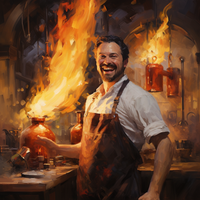Scorch the Sour: The Essential Guide to Burning Your Brewing Equipment
Posted by Matteo Lahm on 21st Mar 2025
Today, we're going to delve into a topic that's as vital as it is often neglected: burning your brewing equipment after crafting a sour beer. You might be wondering, "Why in the world would I need to do that?" Well, let's just say, if you skip this step, your future brews might end up tasting like a cacophony of puckered off-flavors, rather than the harmonious blend you were aiming for.
You've just brewed a batch of your favorite sour beer and you then decided to switch gears and brew a classic lager. You used the same equipment, but when you took that first sip, something was amiss. Instead of the crisp, clean taste you were expecting, there's a sour undertone that's about as welcome as a raccoon at a picnic.
This, my friends, is why "burning" your equipment is so crucial.
When you brew a sour beer, the yeasts and bacteria that give it its unique flavor can linger in your equipment like uninvited guests. If you don't show them the exit, they'll gatecrash your next brewing session and bring their sour flavors with them.
So, how do you burn your equipment? It's not as daunting as it might seem. You don't need a flamethrower or a doctorate in chemistry. All you need is a high-quality cleaner like hot PBW.
Let's start with the cleaning process. You'll want to use a hot PBW, a cleaner that's a favorite among brewers for a good reason. This alkali cleaner is designed to break down proteins, oils, and starches that might be lingering on your equipment. It's like a bouncer for your brewing gear, showing the door to any residue that's overstayed its welcome.
To use it, you'll need to mix the PBW with hot water at a ratio of 1-2 ounces per gallon, following the instructions on the package. Then, give your equipment a thorough scrubbing. Get into every nook and cranny until it's as spotless as a monk's cell. This is where the elbow grease comes in. Don't be afraid to put a little muscle into it however, the hot PBW will make the job easier. Your future brews will thank you.
Once your equipment is squeaky clean, it's time to sanitize. This is the part where you evict those stubborn bacteria and yeasts that might still be hanging around. Use a no-rinse sanitizer for the best results. This type of sanitizer will kill any remaining microorganisms without leaving any residue that could affect the taste of your beer. You can use either Star San or Sulfites.
Remember to follow the instructions on the sanitizer to the letter. This isn't the time to get creative. You want to make sure that every surface that will come into contact with your beer is as clean and sanitary as possible.
By using hot PBW for cleaning and a no-rinse sanitizer, you're giving your equipment the best possible preparation for your next brew. It's a bit like giving your kitchen a deep clean before a big cooking project. It takes a bit of time and effort, but the results are well worth it.
Now, here's where things get a bit specific. This "burning" process works great for glass and stainless steel, but when it comes to softer materials like hoses or plastics, it's a different story. These materials are porous, meaning they can harbor those souring agents deep within their structure, beyond the reach of your sanitizer. In this case, it's best to keep a separate set of equipment for your sour brewing escapades. This way, you can ensure that your non-sour brews remain untainted and true to their intended flavors. For the sake of total transparency, there are some who say this is not necessary however, the nature of the material means that there is a risk that you just might not get your soft gear entirely clean. If you don’t, those cultures will reactivate and, in the end, hoses and airlocks cost less than your beer ingredients and your time.
Remember, brewing is a journey, not a destination. Each batch is a new opportunity to learn and grow as a brewer. So, don't be afraid to make mistakes, and don't shy away from the necessary tasks, like purging your equipment. It might not be the most glamorous part of brewing, but it's as essential as the malt in your stout.
So, go forth and brew, my friends. And remember: when it comes to sour beer, what happens in the fermenter should stay in the fermenter. Happy brewing!


